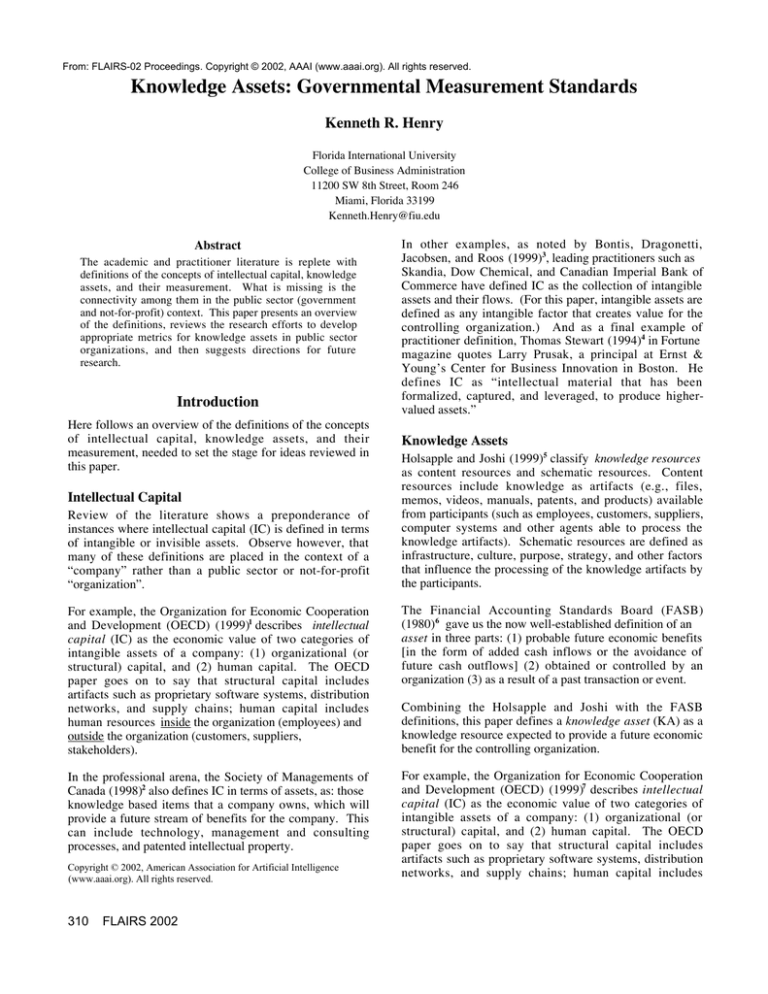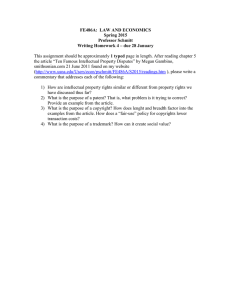
From: FLAIRS-02 Proceedings. Copyright © 2002, AAAI (www.aaai.org). All rights reserved.
Knowledge Assets: Governmental Measurement Standards
Kenneth R. Henry
Florida International University
College of Business Administration
11200 SW 8th Street, Room 246
Miami, Florida 33199
Kenneth.Henry@fiu.edu
Abstract
The academic and practitioner literature is replete with
definitions of the concepts of intellectual capital, knowledge
assets, and their measurement. What is missing is the
connectivity among them in the public sector (government
and not-for-profit) context. This paper presents an overview
of the definitions, reviews the research efforts to develop
appropriate metrics for knowledge assets in public sector
organizations, and then suggests directions for future
research.
Introduction
Here follows an overview of the definitions of the concepts
of intellectual capital, knowledge assets, and their
measurement, needed to set the stage for ideas reviewed in
this paper.
Intellectual Capital
Review of the literature shows a preponderance of
instances where intellectual capital (IC) is defined in terms
of intangible or invisible assets. Observe however, that
many of these definitions are placed in the context of a
“company” rather than a public sector or not-for-profit
“organization”.
In other examples, as noted by Bontis, Dragonetti,
Jacobsen, and Roos (1999)3, leading practitioners such as
Skandia, Dow Chemical, and Canadian Imperial Bank of
Commerce have defined IC as the collection of intangible
assets and their flows. (For this paper, intangible assets are
defined as any intangible factor that creates value for the
controlling organization.) And as a final example of
practitioner definition, Thomas Stewart (1994)4 in Fortune
magazine quotes Larry Prusak, a principal at Ernst &
Young’s Center for Business Innovation in Boston. He
defines IC as “intellectual material that has been
formalized, captured, and leveraged, to produce highervalued assets.”
Knowledge Assets
Holsapple and Joshi (1999)5 classify knowledge resources
as content resources and schematic resources. Content
resources include knowledge as artifacts (e.g., files,
memos, videos, manuals, patents, and products) available
from participants (such as employees, customers, suppliers,
computer systems and other agents able to process the
knowledge artifacts). Schematic resources are defined as
infrastructure, culture, purpose, strategy, and other factors
that influence the processing of the knowledge artifacts by
the participants.
For example, the Organization for Economic Cooperation
and Development (OECD) (1999)1 describes intellectual
capital (IC) as the economic value of two categories of
intangible assets of a company: (1) organizational (or
structural) capital, and (2) human capital. The OECD
paper goes on to say that structural capital includes
artifacts such as proprietary software systems, distribution
networks, and supply chains; human capital includes
human resources inside the organization (employees) and
outside the organization (customers, suppliers,
stakeholders).
The Financial Accounting Standards Board (FASB)
(1980) 6 gave us the now well-established definition of an
asset in three parts: (1) probable future economic benefits
[in the form of added cash inflows or the avoidance of
future cash outflows] (2) obtained or controlled by an
organization (3) as a result of a past transaction or event.
In the professional arena, the Society of Managements of
Canada (1998)2 also defines IC in terms of assets, as: those
knowledge based items that a company owns, which will
provide a future stream of benefits for the company. This
can include technology, management and consulting
processes, and patented intellectual property.
For example, the Organization for Economic Cooperation
and Development (OECD) (1999)7 describes intellectual
capital (IC) as the economic value of two categories of
intangible assets of a company: (1) organizational (or
structural) capital, and (2) human capital. The OECD
paper goes on to say that structural capital includes
artifacts such as proprietary software systems, distribution
networks, and supply chains; human capital includes
Copyright © 2002, American Association for Artificial Intelligence
(www.aaai.org). All rights reserved.
310
FLAIRS 2002
Combining the Holsapple and Joshi with the FASB
definitions, this paper defines a knowledge asset (KA) as a
knowledge resource expected to provide a future economic
benefit for the controlling organization.
human resources inside the organization (employees) and
outside the organization (customers, suppliers,
stakeholders).
In the professional arena, the Society of Managements of
Canada (1998)2 also defines IC in terms of assets, as: those
knowledge based items that a company owns, which will
provide a future stream of benefits for the company. This
can include technology, management and consulting
processes, and patented intellectual property.
In other examples, as noted by Bontis, Dragonetti,
Jacobsen, and Roos (1999)3, leading practitioners such as
Skandia, Dow Chemical, and Canadian Imperial Bank of
Commerce have defined IC as the collection of intangible
assets and their flows. (For this paper, intangible assets are
defined as any intangible factor that creates value for the
controlling organization.) And as a final example of
practitioner definition, Thomas Stewart (1994)8 in Fortune
magazine quotes Larry Prusak, a principal at Ernst &
Young’s Center for Business Innovation in Boston. He
defines IC as “intellectual material that has been
formalized, captured, and leveraged, to produce highervalued assets.”
Industry vs. Government
Consider the question of context! Do definitions of
intellectual capital and knowledge assets change according
to the organizational context? Certainly, on the surface, it
does not appear so. The brief review of concepts thus far
does not distinguish between public service and private
enterprise. Becerra-Fernandez and Sabherwal (2001) 7
propose that context influences the suitability of a
knowledge management process. Similarly, this paper
argues that KA metrics and related standards should
change with context, although basic definitions do not.
Current Measurement Standards for
Knowledge Assets
The literature review suggests a number of approaches to
develop standards. Wilkins, van Wegen, and de Hoog
(1997) 8 evaluate the use of various “proxies” for
knowledge assets (KA) such as human resource
accounting, organizational learning, intellectual property,
and American GAAP (generally accepted accounting
principles). They also review practitioner methods
developed “in the field” by: various corporations (notably
Skandia) to report KA; venture capitalists to evaluate
potential KA-based investments, and commercial lending
institutions, also to evaluate potential financing of KA
investments. Finally, they propose a “framework” of
metrics to define, value, and estimate the economic life of
KA.
Bontis, Dragonetti, Jacobsen, and Roos (1999) 3 review four
measurement “systems”, also popular among practitioners:
(1) human resource accounting, (2) economic value added,
(3) balanced scorecard, and (4) intellectual capital.
Sveiby (2001)9 summarizes methods for measuring IC,
using four classifications:
1. Direct Intellectual Capital (DIC) Methods – to estimate
the value of IC by identifying various components, then
evaluating them directly, either individually, or using an
aggregated coefficient of some kind.
2. Market Capitalization (MCM) Methods – to calculate the
difference between a company’s market capitalization
(market value of outstanding shares) and its
stockholders’ equity (book value of outstanding shares),
as the value of its IC.
3. Return on Assets (ROA) Methods – to calculate average
pre-tax earnings of a company for a period divided by
the average (for the same period) tangible assets of the
company. Excess of ROA over industry average
derives a value for IC.
4. Scorecard (SC) Methods – to identify various nonfinancial components of IC, and report these in
scorecard or graphic form.
Sveiby’s classification suggests that the DIC and SC
methods would work best for public sector (governmental
and not-for-profit) organizations, because the non-financial
metrics are more appropriate for environmental, social, and
public service purposes.
These proposed metrics are all helpful in the quest for
standards in the public sector. However, there is a problem
for accountants and auditors, those primarily responsible
for measuring, recording and reporting on the assets,
including the KAs. Notably, Housel and Kanevsky10,
Walsh (1998)11, and others have explored the idea of
measuring KA by applying a business process audit to
measure KA based on how efficiently an organization
creates [knowledge asset] value from information.
Defining Knowledge Asset Metrics in the
Governmental Context
Keith Bradley (1997) 12 provides some insight to how IC
creates wealth at a corporate level, but suggests there are
lessons to be learned by governmental organizations, for
creating wealth on a national basis. These include setting
appropriate incentives to (1) allow individual “owners” of
IC to benefit, (2) encourage research and development
necessary to create new KA, (3) provide appropriate
education and training needed to transfer KA, and by so
doing increase its value.
Liebowitz and Wright (1999)13 define knowledge as
information with a process applied to it to give ‘valueadded’. Denham Grey (circa 1998)14 expands the notion of
knowledge as both an object and a process. Brailsford
(2001) 15 contributes the concept of a time dimension to
knowledge, from the “knowing what you know”, to
“learning as you go”.
FLAIRS 2002
311
In a governmental or other not-for-profit setting, these
ideas seem to connect best with the human resource
accounting idea of valuing KA based on a future value or
replacement value. In the public sector, especially the US
federal government, this need to evaluate our knowledge
resources has received increasing attention in recent years,
most notably from the Social Security Administration16,
and the General Accounting Office (GAO)17. The GAO
has issued more than 75 reports to Congress since 1995,
expressing concern that various other federal agencies have
not adequately addressed the “graying of government” and
“do more with less” issues that will, sooner or later, result
in a flight of human capital and a severe loss of the human
component of KA, throughout the federal government. For
example GAO report GAO/T-NSIAD-00-13318, with
respect to NASA’s space shuttle program, concludes that
NASA’s downsizing since 1995 “jeopardizes the
program’s ability to hand off leadership roles to the next
generation”.
Liebowitz and Suen (2000) 20 recommend some new
metrics, some of which would also be appropriate in the
public service sector:
Number of new colleague-to-colleague relationships
Rate of reuse of knowledge objects
Number of new ideas for innovative services
Other suggested metrics include:
Incidence of online capture of key expertise (BecerraFernandez, 2000)21
Petty and Guthrie (2000) 22 also suggest the need to identify
new measures, new reporting standards, and new
users/managers for KA resources.
In such an environment, the human resource accounting
concept of valuing KA in terms of future recruitment,
salary and training costs to replace essential staff, seems
most appropriate. But beyond these immediate costs of
replacing the KA, there is a lost opportunity cost caused by
the departure of senior staff, a lost opportunity that is
almost irreplaceable unless adequate preparation has been
made to transfer the tacit knowledge from the exiting
employee to the organization.
David Skyrme (1997)23 describes some guidelines for
success in achieving visible business benefits through the
measurement of IC. However (again), these are guidelines
for private sector rather than not-for-profit/government
organizations. Nevertheless, the suggestions can be easily
transported into the public sector context. (1) Develop a
greater awareness and understanding of the role of
knowledge and nature of intellectual capital in government
and not-for-profit organizations. (2) Create a common
language for organizational use; for example, “intellectual
capital”, “knowledge asset”, etc. (3) Identify appropriate
indicators and criteria for measurement. (4) Develop a
measurement model to provide an appropriate context for
measurement. (5) Introduce measurement and incentive
systems to guide and reward managers
Expressed in a different way, we may conceptualize this
transfer of tacit knowledge as a transfer of the lessons
learned by the senior employees, based on their
professional and organizational experiences. Weber, Aha,
and Becerra-Fernandez (2001)19 explore this idea in a
variety of cases in a range of settings within the US federal
government. Their conclusions include an idea similar to
the one proposed here, that the methods for
institutionalizing these lessons learned are poorly defined,
and the reuse component of the knowledge assets is limited
(another way of saying that lost opportunity costs are high).
Further research opportunities exist for academics and
practitioners to follow up with public service organizations
to develop a better conceptual understanding of knowledge
value and knowledge management peculiar to the public
sector, identify and develop KA measurement standards
based on personnel experience, uniqueness of the service,
quality, innovation, and other non-financial metrics more
suited to that environment. Also, research is needed in the
areas of design, development, and implementation of
systems to capture the knowledge and disseminate the
lessons learned.
Further Research Opportunities
References
The literature review for this paper supports the initial
impression that most of the research in this area has
focused on the private sector. Perhaps this is not so
surprising, because many of the KA valuation metrics and
methods have been developed by or in consultation with
practitioners in the corporate arena. However, there
appears to be growing interest in applying the intellectual
capital, and knowledge management ideas in the not-forprofit sector. This is true particularly in larger
organizations where knowledge resources (artifacts,
participants, and repositories) may be scattered, and the
schematic resources may not be clearly defined. There are
some suggestions that are appropriate for the not-for profit
and government environment.
312
FLAIRS 2002
1
Organization For Economic Cooperation And
Development (OECD), (1999), Guidelines And
Instructions For OECD Symposium, [Amsterdam,
June 1999] International Symposium [On] Measuring
And Reporting Intellectual Capital: Experiences,
Issues, And Prospects, OECD, Paris.
2
Society Of Management Accountants Of Canada
(SMAC), (1998), The Management Of Intellectual
Capital: The Issues And The Practice, Issues Paper
No. 16, The Society Of Management Accountants Of
Canada, Hamilton.
3
Bontis, M., Dragonetti, M. C., Jacobsen, K. And Roos, G.
(1999), The Knowledge Toolbox: A Review Of The
Tools Available To Measure And Manage Intangible
Resources, European Management Journal,
17(4):391-402
4
Stewart, T. A. (1994), Your Company’s Most Valuable
Asset, Fortune, October 3, 1994, p68-74
5
Holsapple, C. W. And Joshi, K. D. (1999), Knowledge
Selection: Concepts, Issues, And Technologies,
Knowledge Management Handbook, CRC Press LLC,
Boca Raton, FL
6
Financial Accounting Standards Board (FASB), (1980),
Statement Of Financial Accounting Concepts No. 3
Elements Of Financial Statements Of Business
Enterprises,
7
Becerra-Fernandez, I. And Sabherwal, R. (2001),
Organizational Knowledge Management: A
Contingency Perspective, Journal Of Management
Information Systems/Summer 2001, 18(1):23-55
8
Wilkins J. Wegen, B. Van, And Hoog, R. De (1997),
Understanding And Valuing Knowledge Assets:
Overview And Method, Expert Systems With
Applications, 13(1):55-72
9
Sveiby, E. K. (2001), Methods For Measuring Intangible
Assets, What’s New At Sveiby Knowledge
Management, Brisbane, Australia,
http://www.sveiby.com.au/intangiblemethods.htm
10
Housel, T. And Kanevsky, V., The LearningKnowledge-Value Cycle: Tracking The Velocity Of
Change In Knowledge To Value, KVA Services,
http://www.businessprocessaudits.com/valuecycle.htm
11
Walsh, D. (1998), Knowledge Value Added: Assessing
Both Fixed And Variable Value , KVA Services,
http://www.businessprocessaudits.com/kvawalsh.htm
12
Bradley, K. (1997), Intellectual Capital And The New
Wealth Of Nations II, Business Strategy Review,
Winter 1997, 8(4):33-45
13
Liebowitz, J. And Wright, K. (1999), Does Measuring
Knowledge Make ‘Cents’?, Expert Systems With
Applications, 17(2):99-103
14
Grey, D. (1998), Grey Matter Inc., Indianapolis IN,
http://www.voght.com/cgi-bin/pywiki?greymatter
15
Brailsford, T. W. (2001), Building A Knowledge
Community At Hallmark Cards, Research Technology
Management, 44,(5):18-25
16
Light, P. C. (2001), Harbingers Of A Troubled Future,
Government Executive, 33(4):90
17
Walker, D. M. (2000), Human Capital: Managing
Human Capital In The 21st Century, United States
General Accounting Office Testimony Before The
Subcommittee On Oversight Of Government
Management, Restructuring, And The District Of
Columbia Committee On Governmental Affairs, U.S.
Senate, GAO/T-GGD-00-77
18
Li, A. (2000), Space Shuttle: Human Capital Challenges
Require Management Attention, , United States
General Accounting Office Testimony Before The
Subcommittee On Science, Technology, And Space,
Committee On Commerce, Science, & Transportation,
U.S. Senate, GAO/T-NSIAD-00-133
19
Weber, R., Aha, D. W. And Becerra-Fernandez, I.
(2001) Intelligent Lessons Learned Systems, Expert
Systems With Applications, 20(1):17-34
20
Liebowitz, J. And Suen, C. Y. (2000), Developing
Knowledge Management Metrics For Measuring
Intellectual Capital, Journal Of Intellectual Capital,
1(1):54-67
21
Becerra-Fernandez, I. (2000), The Role Of Artificial
Intelligence Technologies In The Implementation Of
People-Finder Knowledge Management Systems,
Knowledge-Based Systems, 13(5):315-320
22
Petty, R. And Guthrie, J. (2000), Intellectual Capital
Literature Review: Measurement, Reporting, And
Management, Journal Of Intellectual Capital,
1(2):155-176
23
Skyrme, D. (1997), Measuring Intellectual Capital:
A Plethora Of Methods, David Skyrme Associates,
London England,
http://www.skyrme.com/insights/24kmeas.htm
FLAIRS 2002
313






